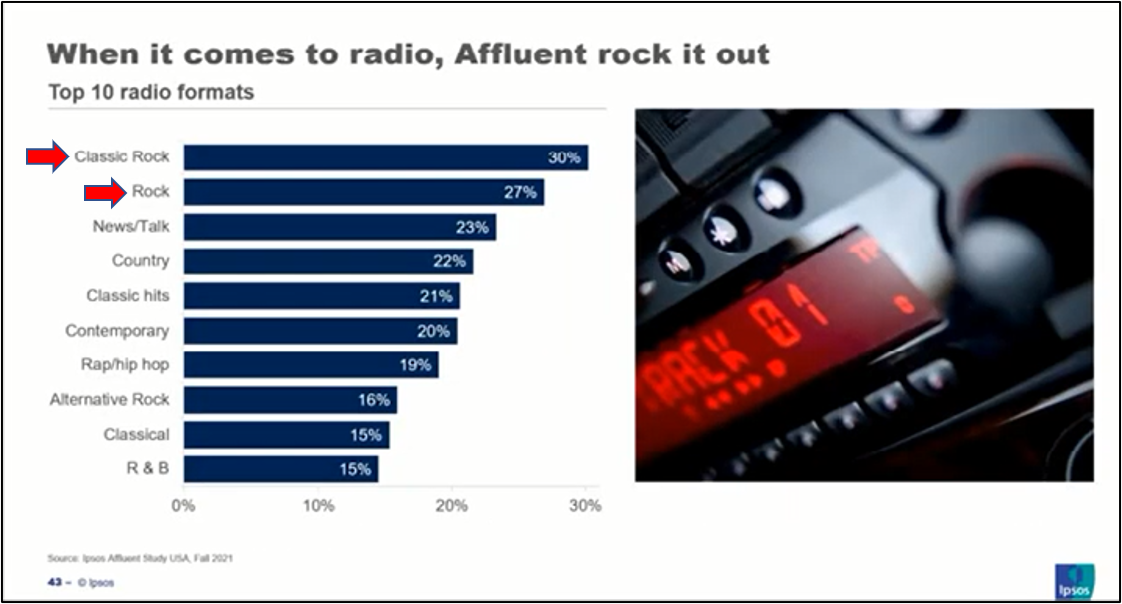Should music marketing focus more on older generations?
The demographics of radio listeners and music fans are changing, and so must marketing strategies.
A guest post by Fred Jacobs of Jacobs Media Strategies.
As we know, things tend to fall into 3’s. And that’s the way it has worked for me these past several days.
I’ve bumped into three different stories about the increasing viability of upper-demographic consumers. Coincidence? I think not.
And I continue to wonder why so many other marketers are “getting the memo,” but somehow, radio remains on the outside, fighting or ignoring the trends.
Making things even worse, broadcast radio’s natural skew is to lean older – an apparently intended consequence after decades of targeting adults, at the expense of young people. Now, there’s an emerging avalanche of Gen Z’s, many of whom cannot distinguish a radio from a fax machine.
In a set of circumstances unique to radio, there’s a ceiling on the medium’s efforts to strategically appeal to its naturally older audience. They’re called 55 year-olds, and they represent a hard demographic stop that even the most imaginative marketers simply cannot break through.
So, when I came across this trifecta of great aging demographic stories – all revolving around highly respected sources – it seemed like just the time to bang my head against the granite walls of radio’s demographic cliff once again, and tell you about them. And maybe, just maybe, you’ll share this post with your friends in the ad industry who often work against their best instincts – and logic – to eschew aging demos most likely to buy stuff – lots of stuff – in this increasingly unpredictable economy.
1. Classic Rock = Affluence. That’s the gist of an Inside Radio story that ran yesterday. A new Ipsos study, “Media Still Matters: Affluent Deep Connection With Media Brands,” points to the radio formats most flush with the affluent.
Ipsos presented a recent webinar that drove home the fact that the more you rock, the more income you make. The favorite radio formats of the affluent (household income of at least $125,000 per year) fall in this order. The percentage represents how many affluents consider each format to be a key choice:

I don’t have to tell you the demographics of Classic Rock. Now that Oldies, Jazz, Soft AC, and Classical have been vanquished from the FM radio dial, radio stations that specialize in AC/DC, Led Zeppelin, Aerosmith, and Queen represent a lot of listeners who have fallen out of ad agency favor while still paradoxically being some of the most affluent citizens in the U.S.
Darrin Stevens and Don Draper knew better. You set your sights on the audience demographic with the most money. It’s counter-intuitive to draw the line at 55 when the wealth skews older. It hurts radio and it hurts their clients who could be reaching those with more buying power.

And here’s some anecdotal proof, royal-style. It turns out Prince William is a self-admitted rock dog. (Or is it a corgi?)
Last I checked, he clearly fits the “affluent” category. Heavy Consequence via Blabbermouth reports the 39 year-old gets psyched up for royal events by cranking AC/DC:
“There’s nothing better than, on a Monday morning, when you’re a bit bleary-eyed after the weekend and trying to get yourself back into the grind of the week, listening to AC/DC, ‘Thunderstruck,’”
Strange…I thought it would be “Moneytalks.”
2. Is the 55+ demographic “on the verge?” That’s the opinion of Phil Rowley (pictured), Head of Futures at Omnicom Media Group, UK. In a recent story in AdWeek – “Marketers Should Prepare for the Great Demographic Disruption” – Rowley made this bold prediction about what’s around the marketing corner:
Marketing will focus less on young people

And he questioned why demographic groupings usually fall into 10-year cells (except 18-24), while marketers use 55+ as a catch-all for matureconsumers. Rowley believes assuming that all mature listeners are the same is naiive and wrong-headed. And as he opines, “This won’t cut it in the future.”
I caught up with him last week, and he was kind enough to answer my question about demographics, marketing, and where we may be headed:
Fred Jacobs: Let’s start with your idea that “marketing will focus less on young people.” Agencies have always been focused on glamorizing youth, and making older people aspire to be younger. Are you seeing tangible signs from advertisers and agencies that there’s opportunity for an older demographic to become more viable and central?
Phil Rowley: Not really. Whilst there are brands who target older demos naturally, like some car brands e.g Porsche, more conservative media outlets like The Daily Telegraph, and of course products designed specifically for the older gen, I’m not sure I see much consideration given to older demos as a growth area.
And that idea of a growth area is most important, because I think in the future, brands with product portfolios would do well to think about how a burgeoning older generation could be brought into their category, though previously excluded. I wrote the article in part to highlight that point.
FJ: The idea of focusing on demographic groups above 54 is intriguing. So, 55-64 and 65-74 make sense. Are you thinking 75+ or even carrying it a bit older to better understand the nuances of generational segments even older?

PR: I think the degree to which older audiences need to be segmented as we see more gradations and subtleties between age-bands, will increase proportional to extensions in lifespan. Right now, I don’t think there’s much difference between targeting an 80 year-old and a 90 year-old. But in 25 years, there may well be.
In the future, we may see campaigns that are targeted at 70-75 year-olds, but not 75-80 year-olds. We’re not there yet, but we may soon will be.
FJ: You mention that older citizens are dictating policy (ex: Brexit). In the States, you could say the same thing about senior voting – always more reliable. Can you elaborate on your thought this will become more pronounced as the older generation grows?
PR: This is slight conjecture on my part, but I have seen no evidence for older cohorts abandoning their priors as they move into old age. Thus, the longer the autumn of life, and the more people there are living through that autumn, the more likely they are to shape public discourse. However, there is an important caveat.
There’s some interesting work done by Steven Pinker in his book “Enlightenment Now,” which highlights a key insight with regard to aging and politics. Namely, that people don’t get more conservative as they get older. They simply keep hold the opinions gained in their formative years, which was the prevailing orthodoxy of the time, and is only conservative by today’s standards.
If people reversed their more liberal opinions in old age, we would also reverse the progress we’ve made on important issues like equal rights. Thus, today’s 30 and 40 year-olds are not about to shift (to the) right as they hit 50 and 60 and 70. But….at any one time, the bigger the older cohort is, the more likely they are to exert disproportionate influence at that moment.

FJ: You contend the demographic shift “is likely to be one of the most profound disruptions in centuries.” How should we be thinking about researching mature consumers – their attitudes, buying patterns, political leanings, etc.?
PR: I’m not sure it matters how you research them, just as long as you do. I think it’s incumbent upon us to update our view of older generations, and actually understanding their journey through the second half of their life.
What may be an interesting angle for insight is, rather like we have a very clear cultural view of pre-50s journey [eg. Teens = education & leisure // 20s-30s = career & relationships // 30s and 40s = family & career], we should build an understanding of how priorities change as the decades stack up, post-50. We should be researching the differences between gradations as life progresses.
FJ: You suggest in the article that marketing strategies may focus less on modern technologies (mobile, Alexa, Clubhouse) but on “using existing and well-loved channels with great efficiency,” while including older people in ad campaigns. Can you comment on the efficacy of traditional marketing channels (radio, TV, print) for reaching mature consumers? Are they still viable or is the future a more hybrid approach that combines legacy media with new media platforms?

PR: I would say broadly that linear TV and linear radio are patronized by older generations – and indeed print. Perhaps more so than younger generations. But as we increasingly become a digitized society, and generations of people like myself who learned to use the internet in the early 90s grow older themselves, and as there is increasing convergence between technologies and media forms, your question will become more difficult to answer.
FJ: How much of the current bias against older demographics exists because of most media buyers and planners being in their 20s and 30s?
PR: This has been a bias traditionally. As I mentioned, advertisers have used youth as the aspirational structure for their campaigns, and by extension the industry has always sought to employ people young enough to understand the audience of tomorrow.
However, I think the last 5 years has seen agencies come alive to their responsibilities from a Diversity and Inclusion perspective. Naturally, this initially focused on race, gender, LGBTQ and neuro-diversity, but I think age is becoming an equally prominent consideration within those workstreams.
Thus, given we have a growing cohort of older audiences, and within the industry we will always have people reaching a level of maturity which previously may have been considered ‘past it.’ I hope to see some movement in our biases here as we attempt to decode older audiences using veterans of the industry who are themselves now part of that cohort.
FJ: What advice would you give to those in media trying to affect change at the agency level? What’s the best way to change hearts & minds on this issue?
PR: To build on the above, I think age needs to be positioned/aligned with Diversity and Inclusion workstreams to ensure we are not automatically ridding ourselves of experienced workers who still have much to give, and can still give you insight into a demo that seems to be growing, yet seems to be painted in broad brush strokes.

3. Here come those crazy septuagenarians – Now that you’re wrapping your head around the concept of a 55-64 demographic becoming viable, in walks Mark Bradbury, AARP Media Solutions senior director of insights and marketing.
Now, you might dismiss him based on his employer, but Bradbury makes a compelling case for the “over-70 demo” in a recent MediaPost story by Todd Wasserman.
Bradbury points out there are already 40 million adults in the U.S. that have cracked “the big 7-0,” and their growth over the next decade is estimated at more than 15 million – twice as robust as the 18-49 year-old demo.
These oldsters are already responsible for more than a trillion dollars of spending on consumer goods and services. Key categories include pharma, health insurance medical supplies, AV equipment, food, personal care, entertain, furniture, and car insurance.
Bradbury maintains their DNA has always been about “promise and possibility.” These Boomers have a feeling of empowerment to continue to live their best lives,” thanks to advancement in medicine and health.”
At a time when radio broadcasters need to expand advertising categories and demographic opportunities, more and more branding experts, marketers, and futurists are logically looking the senior sector of the economy.
For radio, of course, this dovetails perfectly to its sweet spot – consumers who have happily been listeners their entire lives.
Fred Jacobs founded Jacobs Media in 1983, and quickly became known for the creation of the Classic Rock radio format. Jacobs Media has consistently walked the walk in the digital space, providing insights and guidance through its well-read national Techsurveys. In 2008, jacapps was launched – a mobile apps company that has designed and built more than 1,300 apps for both the Apple and Android platforms. In 2013, the DASH Conference was created – a mashup of radio and automotive, designed to foster better understanding of the “connected car” and its impact. Along with providing the creative and intellectual direction for the company, Fred consults many of Jacobs Media’s commercial and public radio clients, in addition to media brands looking to thrive in the rapidly changing tech environment. Fred was inducted into the Radio Hall of Fame in 2018.
Good post. i really enjoy it.
This is true! Great share